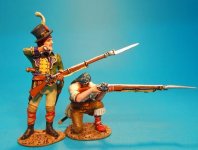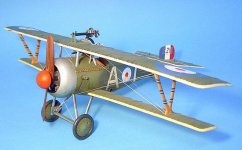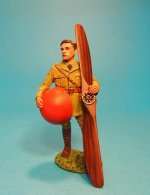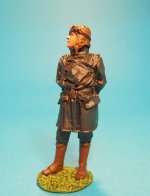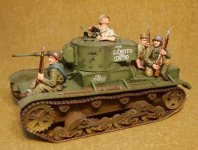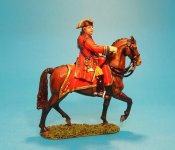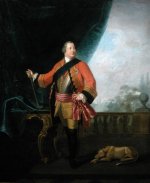Welcome to the June edition of the New releases for John Jenkins, written on a very warm San Francisco Bay Area Day, it feels like mid-summer. The releases for May have arrived and are in stock now!
Well we have a bumper edition this month with releases to please everyone, I think. Including the start of a new series based on the Peninsular War, might be time to watch Sharpe’s Rifles again.
We hope to have these on our web site later this morning.
www.sierratoysoldier.com
As always hope you enjoy them as much as I do.
Best regards
Mike
Sierra Toy Soldier Company
THE PENINSULAR WAR 1807-1814
The Peninsular War series will start with the Spanish Guerillas, who could be called the “Woodland Indians” of the Napoleonic period,….which seemed a suitable place for me to begin.
During the Napoleonic Wars, Napoleon's occupation of the Iberian Peninsula prompted one of the greatest outbreaks of unconventional warfare in military history.
In July 1807, Napoleon invaded the Iberian Peninsula. Napoleon calculated that such a military operation would be relatively easy due to perceived Spanish weakness and inept leadership. If successful, Napoleon could exploit Spain's resources and expand his Continental System, denying the British another important trading partner.
Napoleon did not anticipate the will of the people to resist a foreign invader. Shortly after his successful invasion and defeat of conventional forces, guerrilla warfare ensued. In response to the demands of unconventional warfare, Napoleon's initial invasion force of 50,000 swelled to 80,000 by 1808. Guerrilla tactics employed by ordinary peasants resulted in French forces precariously controlling only the ground they physically occupied
Shortly after Napoleon's invasion of the Iberian Peninsula, organized, regional guerrilla bands emerged. In an effort to quell resistance, the French intensified their efforts at retaliation. Such efforts resulted in guerrilla bands gaining fresh recruits and increased support from the population. One observer remarked, "...the priest girded up his black robe, and stuck a pistol in his belt; the student threw aside his books, and grasped the sword; the shepherd forsook his flock; the husbandman his home."
PSG-01 SPANISH GUERILLAS
Loading and Firing Guerillas #1
(2pcs)
Retail us$78
THE RAID ON ST. FRANCIS
At 26 years old “The Duke” was a Ranger veteran, and had a reputation as a fierce warrior, which he had gained from his valour at the Battle Of Ticonderoga.
For his 3 years of service in the Rangers his owner had granted him his freedom.
He was known as “The Duke” for his blue Indian stockings, his fine white shirts with chitterlings , and his spotted handkerchief.
On leave in New York in July 1759, the bigotry in the colonies was shown in his unfair treatment. Because of an unproven charge of pilfering and his colour, he was picked up and thrown in jail at Goshen in Orange County. Even though his girlfriend “Rosie”, had his freedom papers, the authorities still advertised in the New York Mercury,
”Whosoever owns the said negro, may have him upon paying the charge”
Major Rogers always took care of his own, and managed to obtained “The Dukes” release, just in time for him to volunteer for the St. Francis Raid!
RR-05 Rogers’ Rangers, Jacob “The Duke”
Retail us$39
KNIGHTS OF THE SKIES
Although eighteen other First World War pilots were awarded VC's, none had captured the public imagination as much as Albert Ball. At a time when morale was low, when the war and its casualties seemed never ending, Albert Ball became a symbol of hope.
His individuality and his insistance on fighting alone set him apart from other fighter pilots. His invincible courage and his utter determination made him a legend not only in Britain but also amongst his enemies, to whom the sight of his lone Nieuport Scout brought fear. He was killed, in circumstances still not completely resolved, on May 7th 1917, aged just 20.
A213 was originally built with the French serial number N1579, it was delivered to No. 60 Squadron on 16th September 1916. Albert Ball took over flying this machine on his return from leave in mid-September. He went on to score 11 kills in this plane by the end of September! With his overall score at 31, he returned to England for a rest.
A213 was lost in combat on March 6th 1917, whilst being flown by the CO, Maj. E.P. Graves.
Nieuports purchased from the French before November 1916 were finished in French Olive Drab upper surfaces and Clear Doped Linen undersurfaces. The flight markings are speculative, and based on marking practices of No.60 Sqn at the time.
ACE-06 Nieuport 17, A 213, Captain Albert Ball, No.60 Sqn. RFC September 1916
Retail us$198
*Please note this model has the screw hole for the flight stands* Flight Stands will be available in 2-3 months.
Albert Ball, VC, DSO & Two Bars, MC (14 August 1896 – 7 May 1917) was an English fighter pilot of the First World War and a recipient of the Victoria Cross.
At the time of his death he was, with forty-four victories, the United Kingdom's leading flying ace, and remained its fourth-highest scorer behind Edward Mannock, James McCudden, and George McElroy.
He became the first British fighter ace to capture the public's imagination.
Throughout his flying service he was primarily a "lone-wolf" pilot, carefully stalking his prey from below until he drew close enough to use his top-wing Lewis gun on its Foster mounting, angled to fire upwards into the enemy's fuselage. According to fellow ace and Victoria Cross recipient James McCudden, "it was quite a work of art to pull this gun down and shoot upwards, and at the same time manage one's machine accurately".
Ball crashed to his death in a field in France while pursuing the Red Baron's brother, Lothar von Richthofen. During the engagement he managed to force von Richthofen to the ground, but soon after emerged from a cloud bank upside down and crashed before he could recover. The Germans buried Albert Ball in Annœullin, with full honours.
Ball's death was reported around the world. He was posthumously awarded the Victoria Cross, and also honoured by the government of France and the Aero Club of America.
A memorial service in his home town of Nottingham was attended by large crowds. The year after his death he was commemorated in a biography that included tributes from Prime Minister David Lloyd George, Field Marshal Douglas Haig and General Hugh Trenchard.
Ball's father, a former mayor of Nottingham, memorialised his son in several ways, buying the field where he died, improving his gravesite in Annœullin, and building homes in his honour. Ball is also commemorated by a statue and plaque in the grounds of Nottingham Castle, where his Victoria Cross and other medals and memoriabilia are displayed.
ACE-06P Captain Albert Ball, VC DSO MC
Retail us$39
This figure is based on a photograph of Albert Ball in the garden at Sedgeley House, with the propeller and red spinner from his Nieuport 5173, believed to be taken in October 1916. He flew this Nieuport with No.11 squadron, and on 29th May recorded his second victory. He went on to score a total of 4 more victories in this aircraft which made him officially an ace.
Erich Löwenhardt (April 7, 1897 - August 10, 1918) was the 3rd highest German flying ace with 54 victories during the First World War, behind only Manfred von Richthofen and Ernst Udet.
Oberleutnant Löwenhardt was an aggressive, skilled fighter whose score grew steadily. At the end of May 1918 he received Prussia's highest honour, the Pour le Mérite (Blue Max) after 24 kills. Flying the new Fokker D.VII, he added eight more in June and no fewer than 16 in July. His tally climbed to 53 on 9 August.
The next day, August 10, 1918, Oblt. Löwenhardt shot down a British SE-5 fighter of No. 56 Squadron RAF near Chaulnes (Somme area of France). However, he collided with another Fokker D.VII (of Jasta 11) flown by Leutnant Alfred Wenz, (who bailed out successfully) and though he jumped from his aircraft, his parachute failed to open, and Löwenhardt plummeted to his death from around 12,000 feet. His body was recovered 4 days later. He was 21.
ACE-07P Oberleutnant. Erich Lowenhardt,
Retail us$36
THE SEVEN YEARS WAR
LEUT-02 THE BATTLE OF LEUTHEN 1757 ARMY OF FREDERICK THE GREAT
PRUSSIAN GRENADIER ADVANCING#2
Retail us$39
THE FIRST SUDAN WAR 1884-1885
Captain Frederick Burnaby belonged to an age filled with romantic legends.
He was born in Bedford on 3rd March 1842. After his education at Bedford Grammar School and Harrow, he joined the Royal Horse Guards in 1859.
He travelled with General Gordon in the Sudan during 1875 and later that year he journeyed across the Russian Steppes on horseback. This extremely hazardous equestrian journey resulted in 'A Ride to Khiva' (1876).
In 1876-78 he travelled through Asia Minor and Armenia, later writing about his journey in 'On Horseback through Asia Minor'.
In 1882 he crossed the Channel to Normandy in a balloon, making him the first balloonist ever to cross the Channel alone.
Burnaby died as he had lived: he was killed by a spear at the battle of Abu Klea in the Sudan on 17th January 1885.
BURN-01 Captain Frederick Burnaby,
Retail us$39
To be continued....................
Well we have a bumper edition this month with releases to please everyone, I think. Including the start of a new series based on the Peninsular War, might be time to watch Sharpe’s Rifles again.
We hope to have these on our web site later this morning.
www.sierratoysoldier.com
As always hope you enjoy them as much as I do.
Best regards
Mike
Sierra Toy Soldier Company
THE PENINSULAR WAR 1807-1814
The Peninsular War series will start with the Spanish Guerillas, who could be called the “Woodland Indians” of the Napoleonic period,….which seemed a suitable place for me to begin.
During the Napoleonic Wars, Napoleon's occupation of the Iberian Peninsula prompted one of the greatest outbreaks of unconventional warfare in military history.
In July 1807, Napoleon invaded the Iberian Peninsula. Napoleon calculated that such a military operation would be relatively easy due to perceived Spanish weakness and inept leadership. If successful, Napoleon could exploit Spain's resources and expand his Continental System, denying the British another important trading partner.
Napoleon did not anticipate the will of the people to resist a foreign invader. Shortly after his successful invasion and defeat of conventional forces, guerrilla warfare ensued. In response to the demands of unconventional warfare, Napoleon's initial invasion force of 50,000 swelled to 80,000 by 1808. Guerrilla tactics employed by ordinary peasants resulted in French forces precariously controlling only the ground they physically occupied
Shortly after Napoleon's invasion of the Iberian Peninsula, organized, regional guerrilla bands emerged. In an effort to quell resistance, the French intensified their efforts at retaliation. Such efforts resulted in guerrilla bands gaining fresh recruits and increased support from the population. One observer remarked, "...the priest girded up his black robe, and stuck a pistol in his belt; the student threw aside his books, and grasped the sword; the shepherd forsook his flock; the husbandman his home."
PSG-01 SPANISH GUERILLAS
Loading and Firing Guerillas #1
(2pcs)
Retail us$78
THE RAID ON ST. FRANCIS
At 26 years old “The Duke” was a Ranger veteran, and had a reputation as a fierce warrior, which he had gained from his valour at the Battle Of Ticonderoga.
For his 3 years of service in the Rangers his owner had granted him his freedom.
He was known as “The Duke” for his blue Indian stockings, his fine white shirts with chitterlings , and his spotted handkerchief.
On leave in New York in July 1759, the bigotry in the colonies was shown in his unfair treatment. Because of an unproven charge of pilfering and his colour, he was picked up and thrown in jail at Goshen in Orange County. Even though his girlfriend “Rosie”, had his freedom papers, the authorities still advertised in the New York Mercury,
”Whosoever owns the said negro, may have him upon paying the charge”
Major Rogers always took care of his own, and managed to obtained “The Dukes” release, just in time for him to volunteer for the St. Francis Raid!
RR-05 Rogers’ Rangers, Jacob “The Duke”
Retail us$39
KNIGHTS OF THE SKIES
Although eighteen other First World War pilots were awarded VC's, none had captured the public imagination as much as Albert Ball. At a time when morale was low, when the war and its casualties seemed never ending, Albert Ball became a symbol of hope.
His individuality and his insistance on fighting alone set him apart from other fighter pilots. His invincible courage and his utter determination made him a legend not only in Britain but also amongst his enemies, to whom the sight of his lone Nieuport Scout brought fear. He was killed, in circumstances still not completely resolved, on May 7th 1917, aged just 20.
A213 was originally built with the French serial number N1579, it was delivered to No. 60 Squadron on 16th September 1916. Albert Ball took over flying this machine on his return from leave in mid-September. He went on to score 11 kills in this plane by the end of September! With his overall score at 31, he returned to England for a rest.
A213 was lost in combat on March 6th 1917, whilst being flown by the CO, Maj. E.P. Graves.
Nieuports purchased from the French before November 1916 were finished in French Olive Drab upper surfaces and Clear Doped Linen undersurfaces. The flight markings are speculative, and based on marking practices of No.60 Sqn at the time.
ACE-06 Nieuport 17, A 213, Captain Albert Ball, No.60 Sqn. RFC September 1916
Retail us$198
*Please note this model has the screw hole for the flight stands* Flight Stands will be available in 2-3 months.
Albert Ball, VC, DSO & Two Bars, MC (14 August 1896 – 7 May 1917) was an English fighter pilot of the First World War and a recipient of the Victoria Cross.
At the time of his death he was, with forty-four victories, the United Kingdom's leading flying ace, and remained its fourth-highest scorer behind Edward Mannock, James McCudden, and George McElroy.
He became the first British fighter ace to capture the public's imagination.
Throughout his flying service he was primarily a "lone-wolf" pilot, carefully stalking his prey from below until he drew close enough to use his top-wing Lewis gun on its Foster mounting, angled to fire upwards into the enemy's fuselage. According to fellow ace and Victoria Cross recipient James McCudden, "it was quite a work of art to pull this gun down and shoot upwards, and at the same time manage one's machine accurately".
Ball crashed to his death in a field in France while pursuing the Red Baron's brother, Lothar von Richthofen. During the engagement he managed to force von Richthofen to the ground, but soon after emerged from a cloud bank upside down and crashed before he could recover. The Germans buried Albert Ball in Annœullin, with full honours.
Ball's death was reported around the world. He was posthumously awarded the Victoria Cross, and also honoured by the government of France and the Aero Club of America.
A memorial service in his home town of Nottingham was attended by large crowds. The year after his death he was commemorated in a biography that included tributes from Prime Minister David Lloyd George, Field Marshal Douglas Haig and General Hugh Trenchard.
Ball's father, a former mayor of Nottingham, memorialised his son in several ways, buying the field where he died, improving his gravesite in Annœullin, and building homes in his honour. Ball is also commemorated by a statue and plaque in the grounds of Nottingham Castle, where his Victoria Cross and other medals and memoriabilia are displayed.
ACE-06P Captain Albert Ball, VC DSO MC
Retail us$39
This figure is based on a photograph of Albert Ball in the garden at Sedgeley House, with the propeller and red spinner from his Nieuport 5173, believed to be taken in October 1916. He flew this Nieuport with No.11 squadron, and on 29th May recorded his second victory. He went on to score a total of 4 more victories in this aircraft which made him officially an ace.
Erich Löwenhardt (April 7, 1897 - August 10, 1918) was the 3rd highest German flying ace with 54 victories during the First World War, behind only Manfred von Richthofen and Ernst Udet.
Oberleutnant Löwenhardt was an aggressive, skilled fighter whose score grew steadily. At the end of May 1918 he received Prussia's highest honour, the Pour le Mérite (Blue Max) after 24 kills. Flying the new Fokker D.VII, he added eight more in June and no fewer than 16 in July. His tally climbed to 53 on 9 August.
The next day, August 10, 1918, Oblt. Löwenhardt shot down a British SE-5 fighter of No. 56 Squadron RAF near Chaulnes (Somme area of France). However, he collided with another Fokker D.VII (of Jasta 11) flown by Leutnant Alfred Wenz, (who bailed out successfully) and though he jumped from his aircraft, his parachute failed to open, and Löwenhardt plummeted to his death from around 12,000 feet. His body was recovered 4 days later. He was 21.
ACE-07P Oberleutnant. Erich Lowenhardt,
Retail us$36
THE SEVEN YEARS WAR
LEUT-02 THE BATTLE OF LEUTHEN 1757 ARMY OF FREDERICK THE GREAT
PRUSSIAN GRENADIER ADVANCING#2
Retail us$39
THE FIRST SUDAN WAR 1884-1885
Captain Frederick Burnaby belonged to an age filled with romantic legends.
He was born in Bedford on 3rd March 1842. After his education at Bedford Grammar School and Harrow, he joined the Royal Horse Guards in 1859.
He travelled with General Gordon in the Sudan during 1875 and later that year he journeyed across the Russian Steppes on horseback. This extremely hazardous equestrian journey resulted in 'A Ride to Khiva' (1876).
In 1876-78 he travelled through Asia Minor and Armenia, later writing about his journey in 'On Horseback through Asia Minor'.
In 1882 he crossed the Channel to Normandy in a balloon, making him the first balloonist ever to cross the Channel alone.
Burnaby died as he had lived: he was killed by a spear at the battle of Abu Klea in the Sudan on 17th January 1885.
BURN-01 Captain Frederick Burnaby,
Retail us$39
To be continued....................


